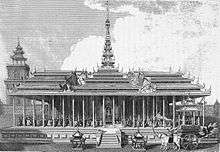Amarapura
| Amarapura အမရပူရ မြို့နယ် | |
|---|---|
| Township of Mandalay | |
| Amarapura Township | |
 | |
 Amarapura Location in Burma | |
| Coordinates: 21°54′N 96°03′E / 21.900°N 96.050°E | |
| Country | Myanmar |
| Region | Mandalay |
| City | Mandalay |
| Township | Amarapura Township |
| Founded | 13 May 1783 |
| Time zone | MST (UTC6:30) |
| Area code(s) | 2 (mobile: 69, 90)[1] |
Amarapura (Burmese: အမရပူရ, pronounced: [ʔəməɹa̰pùɹa̰]) is a former capital of Myanmar, and now a township of Mandalay. Amarapura is bounded by the Irrawaddy river in the west, Chanmyathazi township in the north, and the ancient capital site of Ava (Inwa) in the south. It was the capital of Myanmar twice during the Konbaung period (1783–1821 and 1842–1859) before finally being supplanted by Mandalay 11 km north in 1859. It is historically referred to as Taungmyo (Southern City) in relation to Mandalay. Amarapura today is part of Mandalay, as a result of urban sprawl. The township is known today for its traditional silk and cotton weaving, and bronze casting. It is a popular tourist day-trip destination from Mandalay.
Etymology
Amarapura comes from Pali: Amarapūra (အမရပုရ), which means "city of immortality."[2]
History

Amarapura was founded by King Bodawpaya of the Konbaung Dynasty. He founded Amarapura as his new capital in May 1783.[3] The new capital became a center of Buddhist reforms and learning. In 1800, Buddhist clergy from Sri Lanka obtained higher ordination in this city and founded the Amarapura Nikaya (Amarapura sect).[4]
Bodawpaya's grandson, King Bagyidaw moved the Court back to Ava in November 1821.[5] Bagyidaw's successor King Tharrawaddy again moved the royal capital back to Amarapura in February 1842.[6] In February 1857, King Mindon began building Mandalay as his new capital city, 11 km north of Amarapura. With the royal treasury depleted by the Second Anglo-Burmese War of 1852, Mindon decided to reuse as much material from Amarapura as possible in the construction of Mandalay. The palace buildings were dismantled and moved by elephant to the new location, and the city walls were pulled down for use as building material for roads and railways.[7] Part of the moat is still recognizable near the Bagaya Monastery. The city officially ceased being the capital on 23 May 1859 when Mandalay took over that role.[8]
Sights of interest
- Pahtodawgyi (Amarapura) – A stupa built by King Bodawpaya in 1816 outside the city walls
- Bagaya Monastery – a wooden monastery founded by King Mindon
- U Bein Bridge – a 1.2 km wooden footbridge (longest teak bridge in the world) built by the mayor U Bein salvaging the unwanted teak columns from the old palace during the move to Mandalay
- Kyauktawgyi Pagoda – A stupa built by King Pagan in 1847 at the farther end of U Bein's bridge
- Amarapura Palace ruins – containing tombs of King Bodawpaya and King Bagyidaw, and part of the old moat
- Maha Gandhayon Monastery - a large modern monastery complex with hundreds of monks and novices, well known throughout the country
- Chinese Temple - built in 1838 during King Tharrawaddy's reign
- Yadanabon University - A major liberal arts university for students from Mandalay suburbs
Photos
-

Monks Crossing U Bein Bridge at Sunset
-
U Bein Bridge across the Taungthaman Lake
-
Old City Gate
-
U Bein Bridge, detail
-

U Bein Bridge
-
Amarapura
Notes
References
- Bischoff, Roger (1995). Buddhism in Myanmar - A Short History (PDF). Kandy: Buddhist Publication Society.
- Cooler, Richard M. "The Konbaung Period - Amarapura". Northern Illinois University. Archived from the original on 16 June 2006. Retrieved 2006-06-09.
- Maung Maung Tin (1905). Konbaung Hset Maha Yazawin (in Burmese). 1–3 (2004 ed.). Yangon: Department of Universities History Research, University of Yangon.
- Sein, Hoke. "Entry for amara". Pāḷi-Myanmar Dictionary (ပါဠိမြန်မာ အဘိဓာန်) (in Burmese). Pali Canon E-Dictionary Version 1.94. Retrieved 15 February 2015.
- Sein, Hoke. "Entry for pura". Pāḷi Dictionary (in Burmese). Pali Canon E-Dictionary Version 1.94. Retrieved 15 February 2015.
External links
| Wikivoyage has a travel guide for Amarapura. |
| Wikimedia Commons has media related to Amarapura. |
- Wanderings in Burma George W. Bird, 1897, Southeast Asia Visions
| Amarapura | ||
| Preceded by Ava |
Capital of Burma 13 May 1783 – 22 November 1821 |
Succeeded by Ava |
| Preceded by Ava |
Capital of Burma 10 February 1842 – 23 May 1859 |
Succeeded by Mandalay |
Coordinates: 21°54′N 96°03′E / 21.900°N 96.050°E

